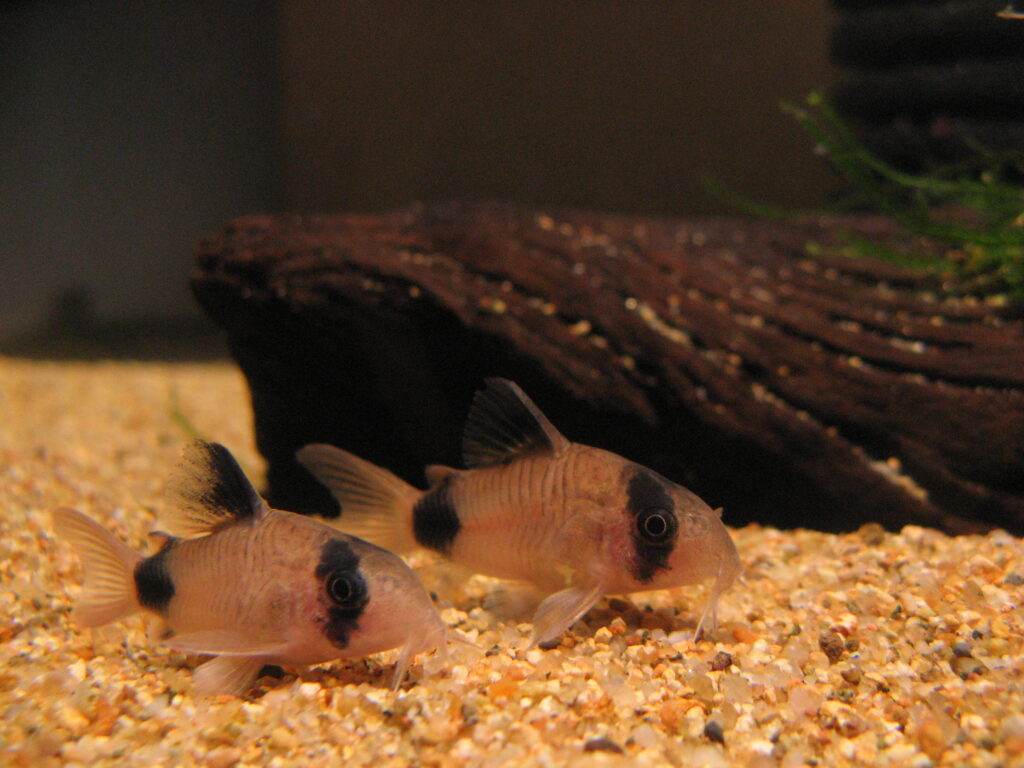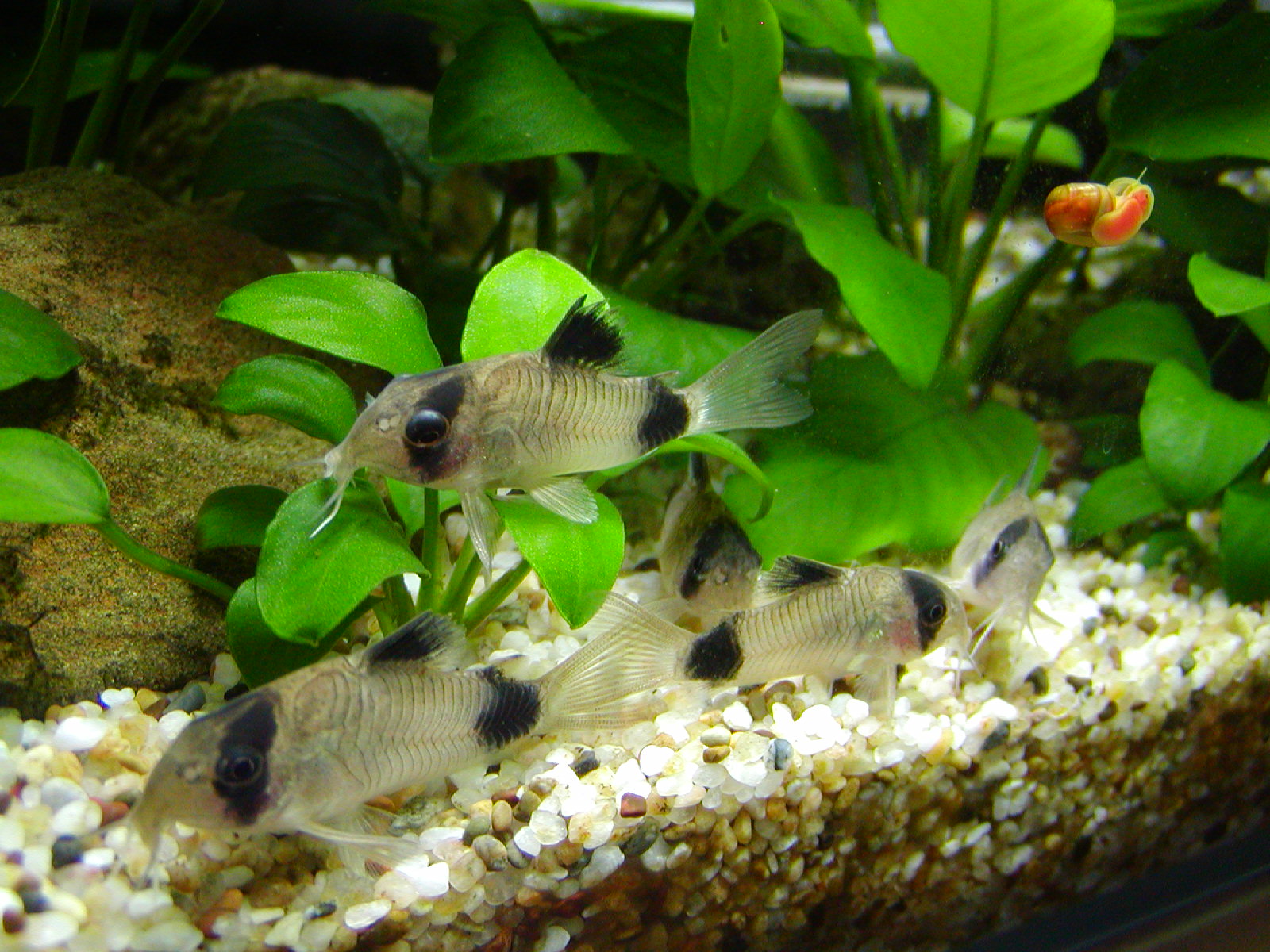Panda Corydoras
The Panda Corydoras, Corydoras panda, is distinguished by its sociable and active demeanor. These fish are captivated by the exploratory experience of their substrates and are distinctly recognizable with their resemblance to the beloved pandas of China. However, being susceptible to diseases, knowledge of proper care is crucial if prospective owners are considering housing them.
- Experience Level: Beginner
- Hardiness: Hardy
- Minimum Tank Size: 20 gal (75 L)
- Maximum Size: 2 inches (5 cm)
- Temperament: Peaceful
- Temperature: 68 – 77° F (20 – 25° C)
- pH Range: 6 – 7
- Water Hardness: 5 – 12 dGH
- Diet: Omnivore
Table of Contents
Introduction
Size and Appearance
Care Guide
Tank Mates
Diet and Feeding
Breeding
The Corydoras panda, colloquially referred to as the Panda Cory or Panda Catfish, originates from Ecuador and Peru where the water characteristics depend on the Andes mountain range. In these regions, these catfish occupy pure water streams and dark water rivers that meander through smooth sand covered bottoms and fine gravel. The high oxygen waters, along with splendid aquatic plant vegetation, offer safe havens and sustenance for the local dwelling species.
When the snowy mountain caps melt, the river currents surge and water temperature plummets to an approximate 66 F (19 C). Habituated to this perennial pattern, the Panda cory has evolved and adapted to endure temperatures as chilling as 54 F (12 C). Notwithstanding, such low temperatures are generally discouraged when it comes to domestic artificial habitats.
Size and Appearance
Female Panda corys, while reaching their maturity, usually achieve a standard size of two inches. Males customarily remain smaller in comparison.
Similar to other species of the Callichthyidae family, the Corydoras panda’s exterior is not furnished with scales but alternatively with overlapping bony plates known as scutes. Think of the hard shell of a scorpion or an armadillo for better visualization.
Differentiating between scutes and scales can be challenging without careful inspection of the catfish. In some armored catfish species, black pigments can be the border marks of individual scutes.
Additionally, the Panda cory boasts three pairs of barbels: a pair of maxillary barbels and two rictal ones. Plus, it has sharp barbs situated under each eye, in front of the dorsal fin, and on the adipose fin, which function as the fish’s defense apparatus.
The body color of Panda Cory ranges between an iridescent white and soft rosy hues which can emit a faint yet mesmerizing emerald shimmer depending upon lighting conditions. Their translucent fins offer an airy celestial impression.
These catfish possess three distinct black markings. The first and largest one covers their heads forming a triangular wedge that surrounds their eyes much like a giant panda’s black face mask. The second mark is located on their dorsal fin while the third one wraps around their caudal peduncle.
Female Corydoras Panda are rounder and larger than males especially when observed from the top, while males are more streamlined and shorter in length.
Care Guide
- Minimum Tank Size: 20 gal (75 L)
- pH Range: 6 – 7
- Water Hardness: 5 – 12 dGH
- Temperature: 68 – 77° F (20 – 25° C)
- Lighting: Moderate, diffused lighting
- Substrate: Fine sand/gravel
- Brackish: No
- Water Flow: Weak/Low
- Tank Region: Mainly Bottom
Although technically classified as a freshwater species, the desirable temperature considered for Panda cory ranges between 68 to 77 F. Their natural habitats show snow-fed cold waters descending from the towering Andean mountains.
By extension, placing the Panda cory in a typically warm tropical aquarium could potentially reduce its lifespan. In cases where an aquarium community is intended, tankmates with similar cold-water preferences should be selected. It is worth noting, however, that specimens bred in captivity may tolerate higher temperatures.
Given the water conditions of their native habitats, water hardness should ideally range between 5 to 12 dGH. Similarly, maintaining a consistent pH level between 6.0 to 7.0 is recommended.
Blackwater rivers become dark due to the presence of rotting wood and terrestrial plants that are rich in tannins, making the water more acidic. There are also rivers that gain their darkness because of the local soil. Regardless, water quality in these rivers remains unaffected.
Panda corys are characteristically brisk and vivacious in their food-seeking endeavors which is why they need a spacious tank even though they do not grow very large. A tank size of 20 gallons (76 liters) would suffice for their needs with an optimal setup requiring a 30-gallon tank (114 liters). While a vegetation-heavy tank can prove beneficial, ensuring enough substrate area remains free for their escapades is crucial.
Known for their love of exploring the bottom, Panda corys should be provided with a sandy substrate, about two to three inches in depth.
Rough substrates should be avoided as they can prove detrimental to these health of these scaleless fish. Using their delicate barbels to search for food, these catfish can end up injuring themselves on abrasive substrates.
Smooth and soft pea gravel is a good alternative to recreate their natural habitat in an aquarium. However, pea gravel can generate dust, hence it would need a good wash before use. Putting the substrate inside a bucket and running water until it clears is an excellent cleaning method.
Panda corydoras can thrive in black water conditions. But, while a recreation of their Amazonian habitat is ideal, water staining might not be necessary. In fact, a well-set tank with plenty of plants would suffice. Keeping in mind the catfish’s preference for bottom-swimming, it would be best to avoid carpet-forming plants to ensure ample free space for swimming.
For those inclined towards creating a miniature blackwater environment, some essential components would include alder cones, dry almond leaves, oak leaves, and a small net bag filled with aquarium-safe peat. These items should be installed and replaced every few weeks to prevent water fouling and help darken the tank water.
Adding driftwood branches, twisted roots, caves, and rocks would give a natural look to the aquarium, making the Panda cory feel at home. Meanwhile, floating plants could be used to subdue the lighting in the tank to cater to the preference of these fish.
Buying Panda corys from reputable pet store chains or online retailers is easy and relatively inexpensive, with prices averaging around $5 per fish, and discounts available for bulk purchases.
Panda corys are peace-loving and great companions in a community tank. However, due to their small size of only two inches, owners should avoid housing them with larger predatory fish.
Apart from water quality, Panda corys are quite easy to accommodate and have relatively simple needs.
Tank Mates
Panda corys are full of energy, almost always in motion, and rarely stationary for long periods. Active predominantly at night, they can still be observed displaying their lively antics during daytime.
Being bottom-dwelling scavengers, they like to sift through the substrate in search of food scraps. However, they are not the best choice for maintaining substrate cleanliness.
Panda corys do not prefer solitude. On the contrary, they exhibit a strong tendency towards social interaction and prefer to be in substantial groups. A minimum set of 8 Panda catfish is recommended with an increase in number proportional to available space.
Friendly towards other larger species, as long as they do not present a threat, Panda corys enjoy the company of other bottom-dwellers, including loaches.
Feeding Guide
- Diet: Omnivore
- Frequency: Several small feedings per day
- Pellet Foods: Yes
- Flake Foods: Yes
- Live Foods: Yes
- Meat Foods: Yes
- Vegetable Foods: Yes
Panda cory catfish are omnivorous and require a combination of plant and vegetable matter coupled with a variety of meat-based food sources.
A Panda cory’s favorite meals include:
- Bloodworms
- Brine shrimp
- Daphnia
- Small earthworms
Adding live food to the tank can result in a feeding frenzy. Hence, care should be taken to ensure fair distribution of food among a large community of fish. Single food items can be placed with tongs beneath decorations or sinking tablets or pellets to resolve this issue.
While Panda corys may snack on some algae, they are not primarily algae-eaters. Panda catfish should not be relied upon as the primary cleaning crew of your tank – there are other more suitable species for this purpose.
Breeding
Panda cory catfish begin to breed around the age of five. Fortunately, thanks to their sociable nature, breeding Panda corys is not very difficult.
To start, it is important to set up a separate breeding tank of around 18 x 12 x 12 inches or similar size, equipped with box-type filtration and adorned with fine-leaved plants like Java Moss.
To boost the chances of successful spawning, maintaining a higher male-to-female ratio is advisable. Conditioning the group with their preferred live or frozen food also increases breeding chances.
When a female appears exceptionally round with ripe eggs, the water should be replaced (50-70%) with cooler water, while ensuring a high level of oxygen. This process simulates the breeding condition these fish usually experience during the wet season in their natural habitat.
The first indications of spawning behavior include enhanced activity and excitement. In the event of a female ready to spawn, she would accept advances from the male. This involves the male caressing the female’s barbels between his pectoral fin and body, which eventually leads to the release of his sperm. In response, the female produces eggs which are fertilized by the male sperm.
After fertilization, the female moves off in search of a suitable hiding spot for the fertilized eggs. This cycle repeats for several hours.
Panda cory eggs typically hatch within four days. The adults should be removed from the breeding tank prior to hatching to prevent them from consuming their own offspring. The young fry should be fed with infusoria until they are ready to consume commercially available foods. The maximum permissible temperature for these baby fish should not exceed 72 F. The distinctive black marks make their appearance three months post hatching.



